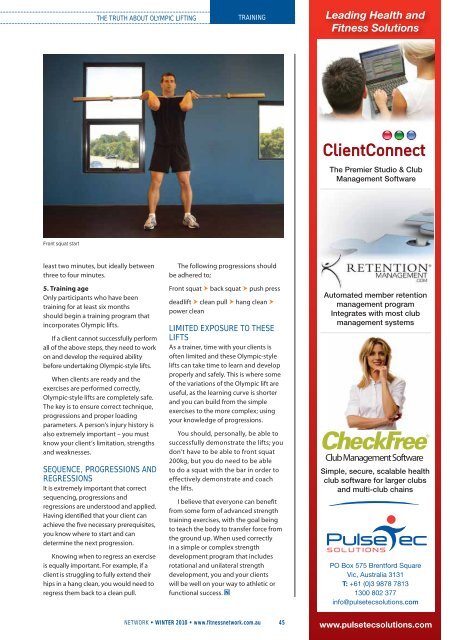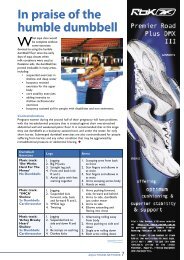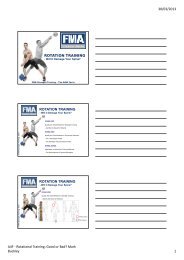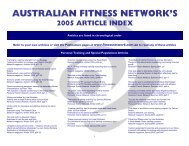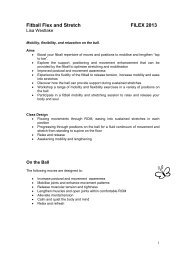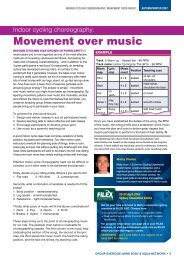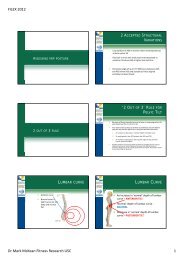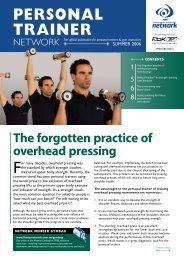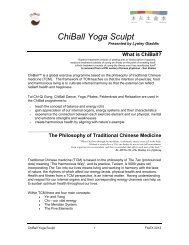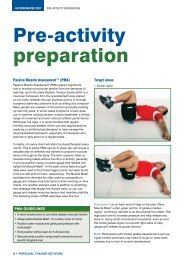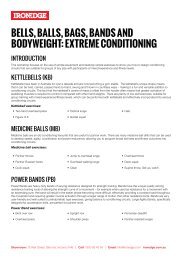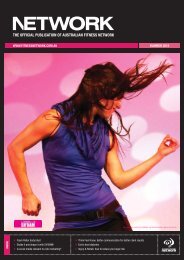CD - Australian Fitness Network
CD - Australian Fitness Network
CD - Australian Fitness Network
You also want an ePaper? Increase the reach of your titles
YUMPU automatically turns print PDFs into web optimized ePapers that Google loves.
Front squat start<br />
THE TRUTH ABOUT OLYMPIC LIFTING<br />
least two minutes, but ideally between<br />
three to four minutes.<br />
5. Training age<br />
Only participants who have been<br />
training for at least six months<br />
should begin a training program that<br />
incorporates Olympic lifts.<br />
If a client cannot successfully perform<br />
all of the above steps, they need to work<br />
on and develop the required ability<br />
before undertaking Olympic-style lifts.<br />
When clients are ready and the<br />
exercises are performed correctly,<br />
Olympic-style lifts are completely safe.<br />
The key is to ensure correct technique,<br />
progressions and proper loading<br />
parameters. A person’s injury history is<br />
also extremely important – you must<br />
know your client’s limitation, strengths<br />
and weaknesses.<br />
SEQUENCE, PROGRESSIONS AND<br />
REGRESSIONS<br />
It is extremely important that correct<br />
sequencing, progressions and<br />
regressions are understood and applied.<br />
Having identifi ed that your client can<br />
achieve the fi ve necessary prerequisites,<br />
you know where to start and can<br />
determine the next progression.<br />
Knowing when to regress an exercise<br />
is equally important. For example, if a<br />
client is struggling to fully extend their<br />
hips in a hang clean, you would need to<br />
regress them back to a clean pull.<br />
TRAINING<br />
The following progressions should<br />
be adhered to;<br />
Front squat � back squat � push press<br />
deadlift � clean pull � hang clean �<br />
power clean<br />
LIMITED EXPOSURE TO THESE<br />
LIFTS<br />
As a trainer, time with your clients is<br />
often limited and these Olympic-style<br />
lifts can take time to learn and develop<br />
properly and safely. This is where some<br />
of the variations of the Olympic lift are<br />
useful, as the learning curve is shorter<br />
and you can build from the simple<br />
exercises to the more complex; using<br />
your knowledge of progressions.<br />
You should, personally, be able to<br />
successfully demonstrate the lifts; you<br />
don’t have to be able to front squat<br />
200kg, but you do need to be able<br />
to do a squat with the bar in order to<br />
effectively demonstrate and coach<br />
the lifts.<br />
I believe that everyone can benefi t<br />
from some form of advanced strength<br />
training exercises, with the goal being<br />
to teach the body to transfer force from<br />
the ground up. When used correctly<br />
in a simple or complex strength<br />
development program that includes<br />
rotational and unilateral strength<br />
development, you and your clients<br />
will be well on your way to athletic or<br />
functional success.<br />
NETWORK WINTER 2010 www.fitnessnetwork.com.au<br />
45<br />
Leading Health and<br />
<strong>Fitness</strong> Solutions<br />
The Premier Studio & Club<br />
Management Software<br />
Automated member retention<br />
management program<br />
Integrates with most club<br />
management systems<br />
Simple, secure, scalable health<br />
club software for larger clubs<br />
and multi-club chains<br />
PO Box 575 Brentford Square<br />
Vic, Australia 3131<br />
T: +61 (0)3 9878 7813<br />
1300 802 377<br />
info@pulsetecsolutions.com<br />
www.pulsetecsolutions.com


